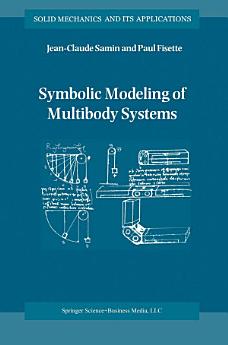Symbolic Modeling of Multibody Systems
J-C. Samin · P. Fisette
জুন ২০১৩ · Solid Mechanics and Its Applications বই 112 · Springer Science & Business Media
ই-বুক
476
পৃষ্ঠা
reportরেটিং ও রিভিউ যাচাই করা হয়নি আরও জানুন
এই ই-বুকের বিষয়ে
Modeling and analysing multibody systems require a comprehensive understanding of the kinematics and dynamics of rigid bodies. In this volume, the relevant fundamental principles are first reviewed in detail and illustrated in conformity with the multibody formalisms that follow. Whatever the kind of system (tree-like structures, closed-loop mechanisms, systems containing flexible beams or involving tire/ground contact, wheel/rail contact, etc), these multibody formalisms have a common feature in the proposed approach, viz, the symbolic generation of most of the ingredients needed to set up the model.
The symbolic approach chosen, specially dedicated to multibody systems, affords various advantages: it leads to a simplification of the theoretical formulation of models, a considerable reduction in the size of generated equations and hence in resulting computing time, and also enhanced portability of the multibody models towards other specific environments. Moreover, the generation of multibody models as symbolic toolboxes proves to be an excellent pedagogical medium in teaching mechanics.
The symbolic approach chosen, specially dedicated to multibody systems, affords various advantages: it leads to a simplification of the theoretical formulation of models, a considerable reduction in the size of generated equations and hence in resulting computing time, and also enhanced portability of the multibody models towards other specific environments. Moreover, the generation of multibody models as symbolic toolboxes proves to be an excellent pedagogical medium in teaching mechanics.
ই-বুকে রেটিং দিন
আপনার মতামত জানান।
পঠন তথ্য
স্মার্টফোন এবং ট্যাবলেট
Android এবং iPad/iPhone এর জন্য Google Play বই অ্যাপ ইনস্টল করুন। এটি আপনার অ্যাকাউন্টের সাথে অটোমেটিক সিঙ্ক হয় ও আপনি অনলাইন বা অফলাইন যাই থাকুন না কেন আপনাকে পড়তে দেয়।
ল্যাপটপ ও কম্পিউটার
Google Play থেকে কেনা অডিওবুক আপনি কম্পিউটারের ওয়েব ব্রাউজারে শুনতে পারেন।
eReader এবং অন্যান্য ডিভাইস
Kobo eReaders-এর মতো e-ink ডিভাইসে পড়তে, আপনাকে একটি ফাইল ডাউনলোড ও আপনার ডিভাইসে ট্রান্সফার করতে হবে। ব্যবহারকারীর উদ্দেশ্যে তৈরি সহায়তা কেন্দ্রতে দেওয়া নির্দেশাবলী অনুসরণ করে যেসব eReader-এ ফাইল পড়া যাবে সেখানে ট্রান্সফার করুন।







